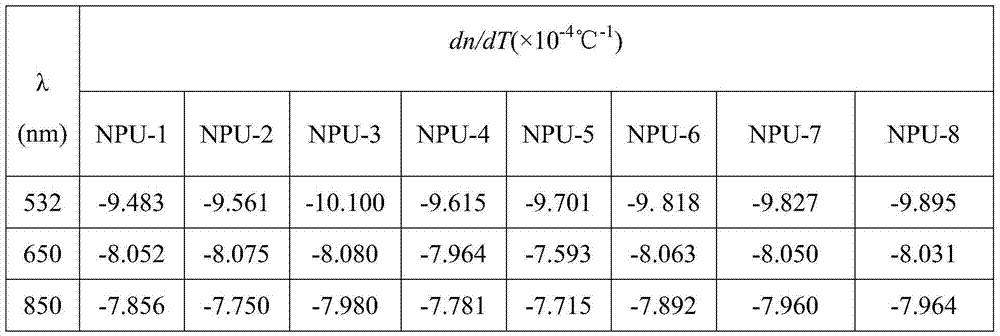A kind of preparation method and application of NCO functionalized graphene/azo polymer composite waveguide thermo-optic material
An azo polymer, functionalized technology, applied in optics, nonlinear optics, instruments, etc., can solve the problem that single-layer graphene is not easy to recombine, and achieve the effects of low driving power, fast response speed, and simple preparation method.
- Summary
- Abstract
- Description
- Claims
- Application Information
AI Technical Summary
Problems solved by technology
Method used
Image
Examples
Embodiment 1
[0023] (1) adopt Hummers method to prepare graphite oxide;
[0024] (2) Add 1.15g TDI and 2.875g DR-19 successively into a 250mL flask containing 11.5g DMF, stir and reflux for 20min. Next, after raising the temperature to 50°C, add 0.5g T-12, and react for 2 hours to obtain a hydroxyl-terminated prepolymer;
[0025] (3) Put 0.0126g of graphite oxide in 6.3g of DMF for ultrasonic peeling for 1h, and then centrifuge to obtain the graphene oxide dispersion. Put the dispersion in a 250mL round-bottomed flask, then add 1.26g IPDI and 1.26g DMF to the graphene oxide dispersion in sequence, and stir and react at 45°C for 2h to obtain IPDIGO. Then, the IPDIGO dispersion was added to the prepared prepolymer, and the stirring reaction was continued for 3h. Finally, the product was filtered through a filter membrane, placed in a vacuum drying oven, and dried to constant weight at 70°C to obtain a reddish-brown NCO-functionalized graphene / azo polymer composite waveguide thermo-optic ma...
Embodiment 2
[0027](1) adopt Hummers method to prepare graphite oxide;
[0028] (2) Add 1.15g TDI and 4.6g DR-19 successively into a 250mL flask containing 23g DMF, stir and reflux for 20min. Next, after raising the temperature to 60°C, add 0.5g T-12, and react for 3 hours to obtain a hydroxyl-terminated prepolymer;
[0029] (3) Put 0.0126g of graphite oxide in 7.5g of DMF for ultrasonic exfoliation for 2h, and then centrifuge to obtain the graphene oxide dispersion. Put the dispersion in a 250mL round bottom flask, then add 2.5g IPDI and 6.8g DMF to the graphene oxide dispersion in sequence, and stir and react at 50°C for 3h to obtain IPDIGO. Then, the IPDIGO dispersion was added to the prepared prepolymer, and the stirring reaction was continued for 4h. Finally, the product was filtered through a filter membrane, placed in a vacuum drying oven, and dried to constant weight at 70°C to obtain a reddish-brown NCO-functionalized graphene / azo polymer composite waveguide thermo-optic materia...
Embodiment 3
[0031] (1) adopt Hummers method to prepare graphite oxide;
[0032] (2) Add 1.15g TDI and 3.45g DR-19 successively into a 250mL flask containing 18.4g DMF, stir and reflux for 20min. Next, after raising the temperature to 80°C, add 0.5g T-12, and react for 4 hours to obtain a hydroxyl-terminated prepolymer;
[0033] (3) Put 0.0126g of graphite oxide in 9.45g of DMF for ultrasonic exfoliation for 6h, and then centrifuge to obtain the graphene oxide dispersion. The dispersion was placed in a 250mL round-bottomed flask, and then 3g of IPDI and 9.45g of DMF were sequentially added to the graphene oxide dispersion, and stirred and reacted at 75°C for 5h to obtain the isocyanide IPDIGO. Then, the IPDIGO dispersion was added to the prepared prepolymer, and the stirring reaction was continued for 6h. Finally, the product was filtered through a filter membrane, placed in a vacuum drying oven, and dried to constant weight at 70°C to obtain a reddish-brown NCO functionalized graphene / a...
PUM
 Login to View More
Login to View More Abstract
Description
Claims
Application Information
 Login to View More
Login to View More - R&D
- Intellectual Property
- Life Sciences
- Materials
- Tech Scout
- Unparalleled Data Quality
- Higher Quality Content
- 60% Fewer Hallucinations
Browse by: Latest US Patents, China's latest patents, Technical Efficacy Thesaurus, Application Domain, Technology Topic, Popular Technical Reports.
© 2025 PatSnap. All rights reserved.Legal|Privacy policy|Modern Slavery Act Transparency Statement|Sitemap|About US| Contact US: help@patsnap.com

